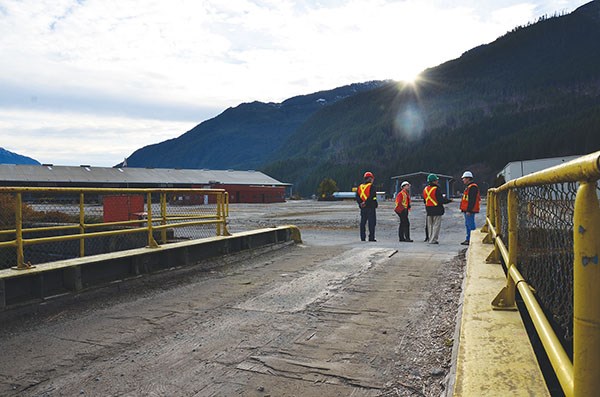Tankers carrying liquefied natural gas (LNG) should stay out of Howe Sound, according to a unanimous motion passed by West Vancouver council July 21.
After hearing numerous environmental concerns, West Vancouver council joined with Lions Bay in calling on the federal government to ban the passage of LNG tankers in Howe Sound.
The motion was a response to an LNG plant proposed for the site of a former pulp mill southwest of downtown Squamish.
Woodfibre Natural Gas Limited — part of the Pacific Oil and Gas group of companies — is seeking to liquefy and export 2.1 million tonnes of LNG per year, beginning as early as 2017. Once operational, the $1.7 billion facility would ship 40 double-hulled LNG tankers to Asia each year.
Recalling the “acid water” that once leached from the Britannia mine, Coun. Bill Soprovich vowed to terminate the terminal.
“This is the most beautiful part of the world and suddenly we’re going to have volatile, dangerous cargo going through it? I think not. The fight is on!” he said.
Soprovich was interrupted several times by applause from the gallery.
Council’s decision not to have a representative from Woodfibre LNG at the meeting was “unfortunate,” according to Marian Ngo, communications manager for Woodfibre.
“We welcome an opportunity in the near future to . . . correct misinformation,” she wrote in an email.
Council’s discussion followed a presentation by Eoin Finn, who — after consulting with several scientists — reached the conclusion that an LNG plant could turn Howe Sound into a “marine desert.”
While a tanker spill is unlikely, the results could be lethal, according to Finn.
The Bowyer Island resident, who holds a degree in physical chemistry, warned that spilled LNG would form a low, combustible fog. If ignited by a passing boat or a cigarette, the fog would burn at 1000 F, according to Finn.
While an LNG terminal could work in an open ocean site, the proposed spot threatens B.C.’s billion-dollar tourism industry, according to Finn.
“This particular location, in a confined watershed, in a very confined waterway, passing three ferry lanes, passing by several major population centres including West Vancouver, is a particularly inappropriate location,” Finn said.
When Woodfibre entered a deal to buy the 89-hectare site in 2013 — which had hosted a pulp mill for nearly a century — the area was sorely in need of environmental remediation.
“It was 100 years of debris offshore, woodchips and logs that basically denuded the foreshore of fish life,” said Byng Giraud, Woodfibre’s vice-president of corporate affairs, when speaking to the North Shore News in February.
The LNG operation would not impact the foreshore, according to Giraud.
Finn said he was not assured, especially given a venting process that will pump approximately 17,000 metric tonnes of chlorinated water per hour into Howe Sound.
“The effect on the sound’s marine ecosystem is unknown,” he said.
While the B.C. Environmental Assessment Office is looking at Woodfibre’s proposal through a working committee, neither West Vancouver, Bowen Island, nor Lions Bay are represented.
Citing concerns including foreshore erosion, supertanker safety, and rogue waves, council passed a motion stating that West Vancouver should be part of any working group related to LNG plants in or around Howe Sound.
The plant’s plans are lacking logic, according to Coun. Michael Lewis, who cited the plethora of proposed projects that could affect Howe Sound, including a garbage incinerator.
“I was sitting on my boat a week ago, looking out into Howe Sound when I had this nightmare of the perfect storm: the LNG tanker coming out from Woodfibre crashing into an oil tanker coming out of Burnaby; but it was all getting mopped up by the stuff coming off the garbage barge,” he said.
Locating an LNG plant where tankers could conflict with recreational boaters raises “a red flag,” said Coun. Trish Panz, noting West Vancouver’s numerous marinas and sailing schools.
“We all expect good, solid regulation in Canada and not having them here is incredibly distressing to me,” she said.
Panz said she was uncomfortable objecting to the terminal’s location, which falls outside West Vancouver’s jurisdiction.
Coun. Craig Cameron disagreed, arguing the terminal could pose as many problems as the tankers.
“We can’t be so parochial and just look at the end of our own noses,” he argued. “If Howe Sound is rendered sterile for example . . . that’s not West Vancouver’s interest, that’s all of our interest.”
Given its deepwater port and gas pipeline, the site is ideal for an LNG plant, according to Giraud.
Woodfibre LNG is working with Fortis to twin a 52-kilometre pipeline, which would loop from the top of the Coquitlam watershed to the Squamish site.
Construction of the LNG plant would require 600 workers. Once operational, the plant would have a staff of 100 full-time workers.




